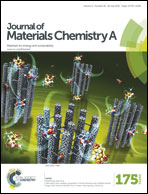Exploring the mixed transport properties of sulfur(vi)-doped Ba2In2O5 for intermediate-temperature electrochemical applications
Abstract
A stabilised orthorhombic perovskite Ba2In1.8S0.2O5+δ was synthesised by a solid state reaction at low-temperature. The mixed (electronic–protonic–oxide-ionic) conducting properties of this composition were investigated in detail for potential interest in a wide range of membrane applications including protonic ceramic fuel cells. The electrochemical analyses performed include impedance spectroscopy under wet/dry conditions of N2 and O2 and modified electromotive force measurements in wet/dry mixtures of N2/O2. Under dry oxidising conditions, the sample possesses mixed electronic–oxide-ionic contributions to the electrical transport in the whole range of temperatures, associated with the equilibrium between oxygen vacancies and holes. In wet atmospheres, protonic species arise from the hydration reaction. Protons represent the dominant charge carriers for temperatures lower than 550 °C, while oxide-ions and holes are the major mobile species for temperatures higher than 700 °C. Appreciable mixed contributions to the electrical transport from protons, oxide ions and holes are confirmed between 550 and 700 °C. The experimental data obtained from modified electromotive force measurements and impedance spectroscopy fit well with the expected results according to the proposed defect chemistry model.


 Please wait while we load your content...
Please wait while we load your content...